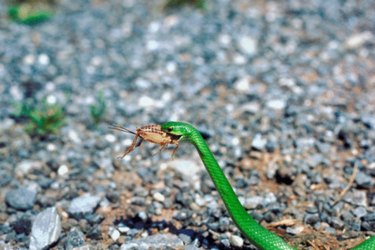
Crickets form the basic diet for many pet reptiles. They were once kept for fighting in China, and some people enjoy their chirping. Raising crickets is a way to feed your own pets cheaply or to make a little extra money by selling them on to hobbyists and pet stores. Crickets are also straightforward insects for children to keep as pets or for a science project. A cricket terrarium is simply a tank outfitted to form a suitable environment for raising or breeding crickets.
Tank
Video of the Day
A glass or plastic fish tank of about 10 gallons or larger forms a suitable cricket house. Obviously, the larger the tank, the more crickets it can hold. Old fish tanks with leaks work perfectly well, provided there are no gaps the crickets could escape through. Large, transparent plastic boxes are a good alternative. Since mold and mites can be a problem, it is usually best to replace the lid with a sheet of cheesecloth held on with an elastic band. This provides plenty of ventilation. People planning to breed a continuous supply of crickets need at least two tanks, one for breeding adults and one for eggs and juveniles. Adult crickets may otherwise eat the babies. A heat lamp is necessary if the surrounding temperature is likely to fall below about 70 degrees F. Crickets thrive at about 85 degrees F.
Video of the Day
Substrate
For ease of cleaning, the easiest substrate for crickets is paper. Old newspapers or paper tank liners can be simply removed and replaced each time you clean the tank. The used papers are suitable for home composting. Shallow dishes with a couple of inches of damp potting compost give the insects somewhere to lay their eggs. Move the dishes to a second tank afterward. If you want your cricket terrarium to look natural, use a substrate of dry potting compost or sand throughout the tank. The substrate needs replacing every two weeks or so, depending on the size of the tank and the number of crickets.
Accessories
Places for the crickets to perch and hide allow you to keep more crickets in each tank. The opportunity to show natural behavior and hide from perceived threats stops crickets getting stressed and keeps them healthy. Pieces of bark, cardboard egg boxes or small clay pots or their sides are good cricket hiding places. You could also add a few twigs.
Food and Water
Two small bowls are necessary for food and water. Crickets need to drink. To stop them drowning in a water bowl, either fill the bowl no deeper than the smallest cricket in the tank or soak cotton balls in water and place in a dish. Crickets are omnivores; they eat a mixture of animal and plant matter. Dog kibble and vegetables makes an adequate diet. Pet supply stores also sell ready-made cricket food, including nutrient-rich preparations you feed to or dust on crickets just before feeding them to reptiles.